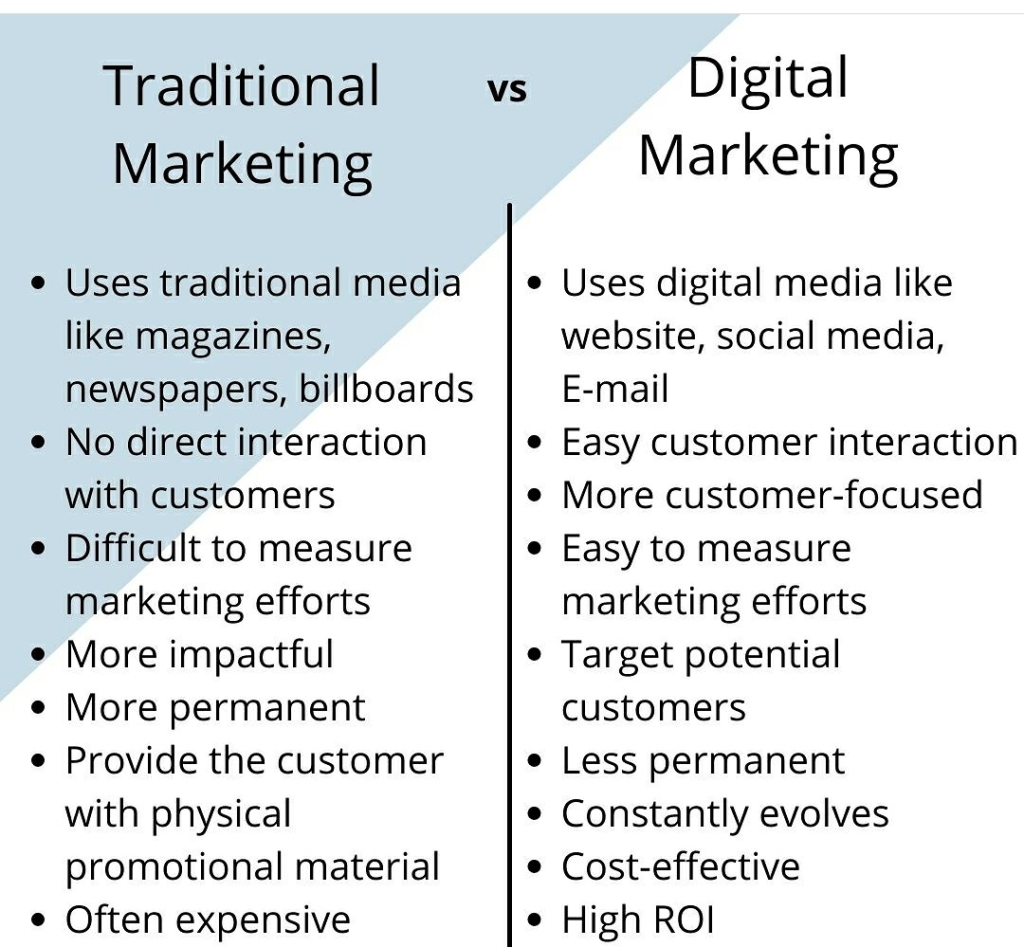What is Digital Marketing?
Digital marketing refers to the use of electronic devices for conveying promotional messages and measuring their impact throughout the customer journey. It encompasses various forms, including online video, display ads, search engine marketing, paid social ads, and social media posts, in contrast to traditional marketing methods like magazine ads and billboards. More than 75% of Americans go online daily, with a significant portion being online frequently, making it crucial for marketers to establish a strong online presence. Digital marketing strategies involve utilizing channels like social media, pay-per-click, SEO, and email marketing to connect with existing and potential customers, build brand recognition, enhance the customer experience, and attract new prospects.
What is Traditional Marketing?
Traditional marketing encompasses marketing techniques that were in use before the digital marketing era. It relies on offline media to reach its audience. Examples of traditional marketing include print ads in newspapers and magazines, billboards, direct mail advertisements, and TV and radio advertisements. These methods were prominent before the rise of digital marketing and are still used alongside digital strategies to reach a diverse audience. Traditional marketing, also known as offline marketing, refers to conventional advertising and promotional methods that were in use before the advent of digital technologies and the Internet. It involves reaching out to a target audience through offline channels and mediums.
The difference between Digital Marketing and Traditional Market

- Medium and Channels:
- Digital Marketing: Digital marketing operates through online channels and platforms. It includes websites, social media, email marketing, search engines (e.g., Google), mobile apps, and online advertising networks.
- Traditional Marketing: Traditional marketing relies on offline channels such as print media (newspapers, magazines), broadcast media (TV and radio), direct mail, billboards, and in-person events.
- Cost and Budgeting:
- Digital Marketing: Digital marketing campaigns can often be more cost-effective, with flexible budgeting options. Businesses can adjust their spending based on the performance of online ads and campaigns.
- Traditional Marketing: Traditional marketing tends to be more expensive, with fixed costs for print, radio, or TV advertising. Changing or adjusting these campaigns can be costly.
- Targeting and Personalization:
- Digital Marketing: Digital marketing allows for highly targeted and personalized campaigns. Marketers can reach specific demographics, interests, and behaviors, often in real-time.
- Traditional Marketing: Traditional marketing has less precise targeting. Advertisers may need to rely on general audience demographics rather than specific interests or behaviors.
- Interactivity and Engagement:
- Digital Marketing: Digital marketing offers interactive and engaging content. It allows for two-way communication with the audience through comments, likes, shares, and direct messages.
- Traditional Marketing: Traditional marketing is typically one-way communication with limited opportunities for audience engagement.
- Measurability and Analytics:
- Digital Marketing: Digital marketing provides extensive analytics and metrics to track campaign performance in real-time. Marketers can measure clicks, conversions, ROI, and more.
- Traditional Marketing: Traditional marketing offers limited measurability, making it challenging to determine the exact impact of a campaign.
- Global vs. Local Reach:
- Digital Marketing: Digital marketing has a global reach, making it possible to target both local and international audiences.
- Traditional Marketing: Traditional marketing is often more focused on local or regional audiences.
- Speed and Timing:
- Digital Marketing: Digital campaigns can be launched quickly, and changes can be made in real-time. It’s highly responsive to market changes.
- Traditional Marketing: Traditional marketing campaigns require longer lead times and are less adaptable to sudden market shifts.
- Environmental Impact:
- Digital Marketing: Digital marketing is generally considered more environmentally friendly since it doesn’t involve physical materials like paper or ink.
- Traditional Marketing: Traditional marketing may have a greater environmental impact due to the production and disposal of physical materials.
